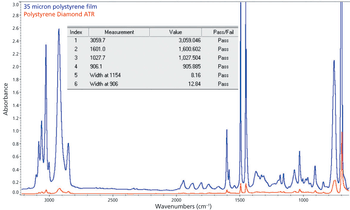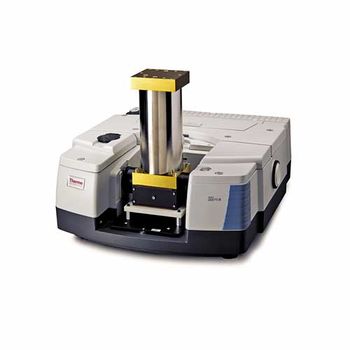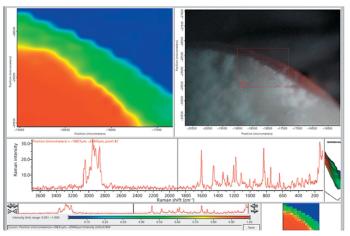
This note demonstrates the capability of the latest ICP-OES technology for robust and sensitive analysis of REE and metals in electronic waste.

This note demonstrates the capability of the latest ICP-OES technology for robust and sensitive analysis of REE and metals in electronic waste.

The promises of the digital lab are enticing but getting there can seem daunting. The good news is that you can start today. It’s simply about implementation, and not waiting for innovation. Live: Tuesday, Sept. 22, 2020 at 11am EDT| 8am PDT| 4pm BST| 5pm CEST On demand available after airing until Sept. 22, 2021

Isotope fingerprints provide forensic investigators with a unique characterization of sample material, trace reactants, chemical pathways, and reaction conditions.

Near infrared (NIR) spectroscopy to the rescue: See how this vital process analytical technology tool can improve efficiency and cut costs in your pharmaceutical QC processes. Live: Wednesday, Sept. 9, 2020 at 11am EDT | 8am PDT | 4pm BST | 5pm CEST On demand available after airing until Sept. 9, 2021

This application note describes standard test method ASTM D5185 for determination of additive elements, wear metals, and contaminants by ICP-OES.

Discover the latest advancements in trace element analysis presented at the 2020 Winter Conference on Plasma Spectrochemistry, focusing on simplification of your workflow, advanced inference removal, and improved sample introduction. Live: Thursday, Jan. 30, 2020 at 11am EST | 8am PST | 4pm GMT | 5pm CET On demand available after airing until Jan. 30, 2021. Register free

There is a famous reindeer who has a red nose. But what if his red nose was an infrared-nose that helped us identify and confirm the various things we encounter during the holiday season? In this fun holiday web seminar we’ll discover the answers to these questions and more with real FTIR science and microscopy. By using transmission, reflection, ATR, rapid scan, multi-component analysis and other capabilities we’ll be able to put these holiday materials to the test. Learn what you can see with FTIR using everyday holiday samples. Live: Tuesday, December 17, 2019 at 11am EST | 8am PST | 4pm GMT | 5pm CET On demand available after airing until Dec 17, 2020. Register free

Hydrogen and oxygen stable isotope measurements on roasted coffee samples trace the origin of coffee beans based on unique trends observed from their isotopic fingerprints.

The measurement of carbon, nitrogen and sulfur isotope fingerprints of PM2.5 particles on quartz filter papers allows source identification.

With isotope fingerprints sources of pollution, monitor water and air quality and track environmental change across space and time can be traced. Isotope Ratio Mass Spectrometry detects the “isotope fingerprint” of a sample, a unique chemical signature that changes from sample to sample across the environment.

Hydrogen and oxygen stable isotope measurements on roasted coffee samples trace the origin of coffee beans based on unique trends observed from their isotopic fingerprints.

Synthetic copies of endogenous steroids are chemically and pharmacologically identical to their endogenous analogs. Analyzing isotopes of the steroids provide characteristic isotope fingerprints of urinary steroids and offer a discrimination framework.

Analysis of cocaine seized from an “aircraft drop” in Uruguay led to the discovery of a previously unknown coca growing region in northern Bolivia.

This application note demonstrates analysis of elemental impurities, such as arsenic, in vitamin B12 according to USP chapter , using triple quadrupole ICP-MS.

This application note demonstrates the routine automated multi-element analysis of environmental samples using triple quadrupole ICP-MS.

Join us to hear how routine industrial laboratories leverage the advantages of triple quadrupole ICP-M technology to improve their throughput and performance. Live: Wednesday, Oct. 9, 2019 at 11am EDT | 8am PDT | 4pm BST | 5pm CEST On demand available after airing until Oct. 9, 2020. Register free

Can isotopes help determine pollution sources? Find out how isotope fingerprints can support implementing preventive measures and limit the damage caused by pollution, by knowing its sources. Live: Wednesday, September 25, 2019 at 11am EDT | 8am PDT | 4pm BST | 5pm CEST On demand available after airing until Sept. 25, 2020. Register free

Standardized methods (or official international methods) exist for stable isotope analysis of food and beverage samples and are aimed at protecting product origin, authenticity and label claims.

Take the stress out of the harvest season with automated sample analysis! Ensure your product is the same year-to-year with fully automated, extremely reliable and specific QC testing throughout the growing process! Live: Friday, Dec. 14, 2018 at 11am EST | 8am PST | 4pm GMT | 5pm CET / On Demand: available after airing until Dec. 14, 2019. Register free: http://www.chromatographyonline.com/lcgc_w/accurate


High resolution mass spectrometry with nano-LC is used for protein identification and quantification in both top-down and bottom-up proteome analysis. Reliable instrumentation in combination with ultrapure mobile phases is essential for data integrity. Premixed 80% acetonitrile with 0.1% formic acid (LS122-500) and water with 0.1% formic acid (LS118-500) were designed to produce a consistent chromatographic performance using this instrument system. In this study, these mobile phases were used extensively to evaluate several factors which can affect separation of protein digests such as peak retention, peak repeatability, and sample carryover. Our results demonstrated excellent chromatographic performance using Thermo Scientific EASY-nLC 1200 LC system and Thermo Scientific LTQLX ™ ion trap mass spectrometer with the specialized premixed mobile phases.

Combining a high precision FT-IR spectrometer with a long pathlength gas cell provides a powerful tool for analyzing trace levels of contaminants in air and other gas mixtures.

In this executive summary learn how to use isotope-ratio MS to determine the isotopic profile or “signature” of a material, and to hear about how this technique can be used in forensic investigations to measure a variety of materials, including drugs, explosives, currency, food, beverages, animal tissues like ivory, and human remains.

The development of an analytical method for ICP-OES is often seen as challenging, due to the large number of sample introduction components on the market, the possible parameters for sample introduction and plasma and measurement conditions, and finally, questions about how to interpret the data. This executive summary will demonstrate how to achieve your goal when developing a method: determining a set of parameters that ensure an accurate, precise and repeatable result on a daily basis.

Analysis of trace elements in petrochemical samples is routinely carried out for quality control and process monitoring using protocols set by organizations such as ASTM. However, analysis of these samples is often challenging due to the high matrix and potential for interferences. This executive summary will provide essential information on how to develop robust methods over coming these challenges and ensure excellent results when analyzing trace elements in petrochemicals samples by ICP-OES.

To learn more about Method development for ICP-OES, Spectroscopy Magazine talked with Matthew Cassap, Product Manager ICP-OES, AA, and Trace Elemental Analysis at Thermo Fisher Scientific.

Introducing a new single quadrupole ICP-MS to the range of trace elemental analysis solutions offered by Thermo Scientific. To learn more, Spectroscopy Magazine talked with Shona McSheehy-Ducos, ICP-MS Product Manager, Thermo Fisher Scientific in Bremen, Germany.

Infrared and Raman spectroscopy are critical analytical techniques in the pharmaceutical industry, used for the structural elucidation and characterization of organic materials such as new drug candidates, impurities, metabolites, and excipients.

Combining a high precision FT-IR spectrometer with a long pathlength gas cell provides a powerful tool for analyzing trace levels of contaminants in air and other gas mixtures (Figure 1). Two important applications of this are ensuring air quality and the purity of breathing oxygen and compressed air.